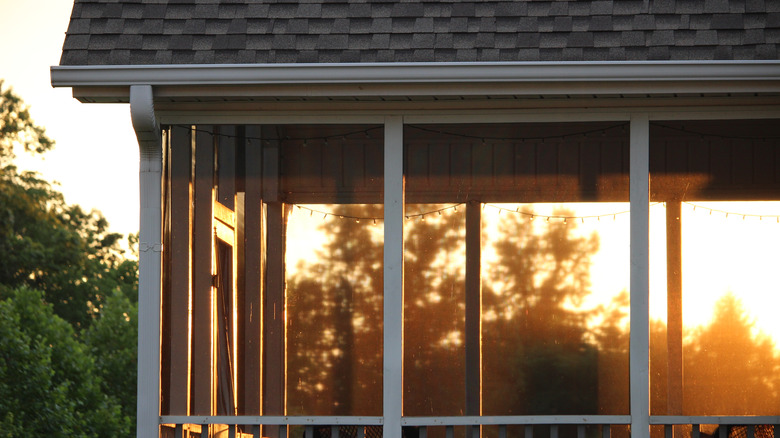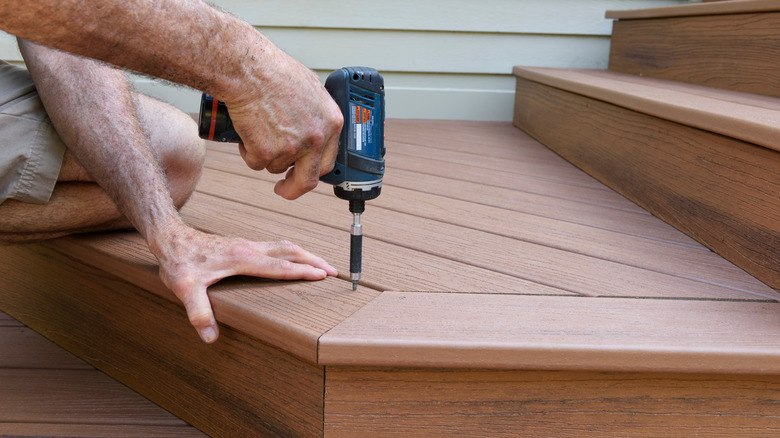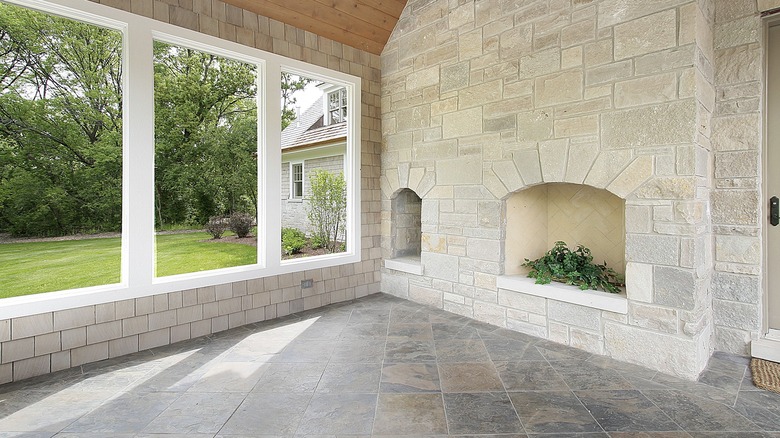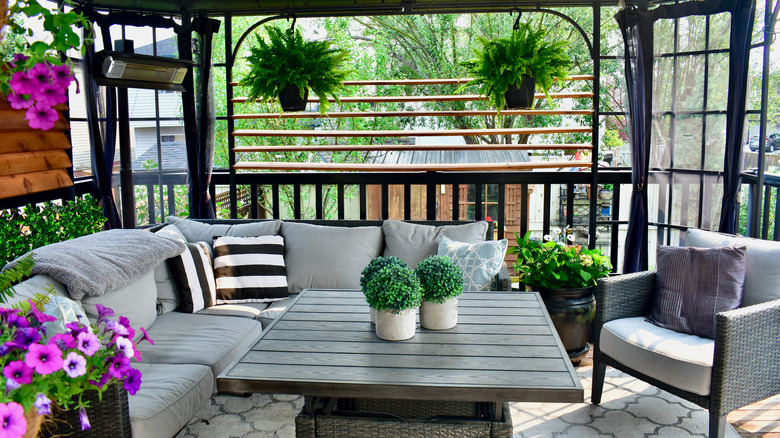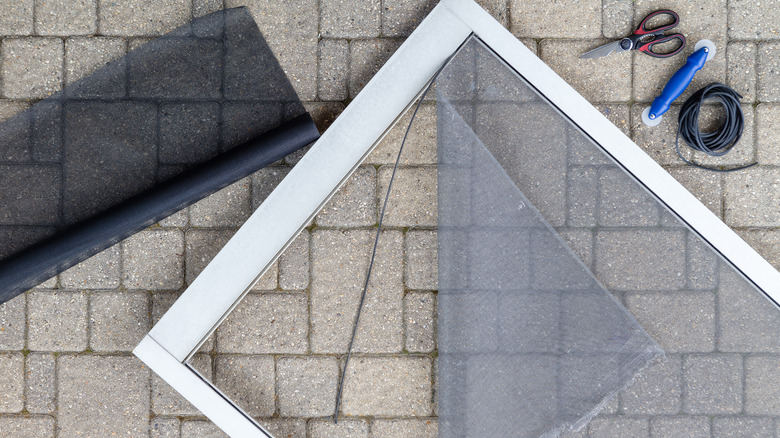How Much Does It Cost To Build A Screened-In Porch From Scratch?
A screened-in porch is an outdoor area that has been enclosed by some form of side panels and a roof, explains St. Louis. Although some may find a structure like this contradicting, it helps expand the living area of a property by providing a fully protected but useable space outside the home, while still giving the feeling of being outside.
Screened-in porches can come in a variety of sizes and designs. Home Advisor states that one of the most common sizes for a porch is around 200 square feet, which can range between $4,600 and $22,000 for installation, with an additional $2,000 to $2,800 to add the screens. When it comes to materials, many homeowners decide to make the main structure from a simple wooden frame, similar to an average porch. You may also choose to include stone, tile, or concrete flooring. Besides structural materials, Home Depot states that of the many types of screens available, fiberglass screening is without a doubt the most common, due to its cheap price and ease of installation. If you're looking to increase the exterior elements of your home with this type of versatile structure, then join us as we break down the costs and find the perfect screened-in porch for both your home and your budget.
Factors for cost
When building a screened-in porch, there are many elements that factor into the overall cost of the project, such as existing structures, design complexity, location restrictions, and materials. Let's take a closer look at these factors below.
Existing structures
Sometimes, building a screened-in porch completely from scratch isn't entirely necessary. Some homes already include a structure that extends from the back, front, or side of the house, like a deck or a patio. In this case, the existing structure can easily be converted into a screened-in porch, decreasing the overall price of the project, suggests U.S. News. This can be done by either adding a screened-in portion to your already existing structure or by adding screens to the area underneath if the space happens to be livable.
Home Advisor states that simply enclosing an area of your porch should cost between $19 and $37 per square foot, depending on the materials used. If you plan on completely converting the area into a living space with extra protection from the outdoors and more indoor elements, prices can range between $120 and $300 per square foot. Screening in an area underneath your porch is a much cheaper option as the roof structure is already present, while the aluminum screen panels cost between $5 and $7 per square foot.
Location
Although the location of your home may not sound particularly relevant to your project, it still plays a significant role in the overall cost of a screened-in porch. Your location can determine the availability of materials and labor, possibly making the job more expensive. Your location can also affect the delivery of materials due to limited shipping options for your area.
On top of these direct limitations, depending on the area where you live and laws outlined for that specific location, U.S. News states that there might be local zoning and permit requirements that need to be obtained before the construction process begins. Many local governments require specific approval for the creation of a permanent structure that includes a roof, as it is considered a direct extension of the home. This may also mean that architectural plans must be submitted and overall approval needs to be obtained from the local government, which can add $100 to $500 to the overall cost of the project, according to Home Advisor.
Size and materials
It stands to reason that the more space you wish to convert, the more expensive the price will be. However, the type of materials you choose to build from play an even bigger role in the overall price. The main materials you will need to make a screened-in porch include the side screens, a door, decking, and a roof.
When it comes to screens for your porch, Home Advisor mentions that there are four main types to choose from. The most popular and cheapest type is a fiberglass screen, which ranges between $4.50 and $5.50 per square foot. Aluminum and solar screens are also great options that range between $5 and $7 per square foot. For something a bit more luxurious, motorized retractable screens are also available for around $2,000 to $4,000 per unit.
If you do not already have a deck or patio to use then the total cost will be significantly higher, depending on the size of decking you wish to build. For an average 200-square-foot deck, expect to pay between $800 and $10,800 for the decking material. Adding a roof or any other covering to the structure will add between $3,200 and $6,000 to the overall cost. Other elements you may also want to think about are steps, posts, railing, and a screen door. Depending on the types of materials you use for these elements, the total cost can range between $1,175 and $6,200 for an average 200-square-foot structure, bringing the total cost of a screened-in porch to between $6,900 and $25,100, (via Home Advisor).
Labor
Home Advisor also states that the average labor cost for screening a porch usually hovers around $2 for every square foot. Although this may not sound like much, this means the total cost of labor is around $400 for an average 200-square-foot structure. There are, however, other options; Home Advisor explains that depending on the complexity of the screened-in porch, the construction can be just as successfully completed if you do it yourself. Despite the amount of money saved by doing the project on your own, there are still benefits of hiring a professional crew, including the project being completed in a timely manner, the finished job is guaranteed against structural defects, and the ability to adjust the design to your exact liking.
Additional costs
When adding an outdoor area to your living space, you will eventually need to think about ways to make that outdoor space more comfortable and enjoyable. Any additional features or elements will ultimately affect the final budget.
Electricity
U.S. News states that the best way to bring comfort to your outdoor space is to install electricity. This can prepare the way for a variety of home comforts, including lighting, television and audio equipment, and heating or cooling appliances. Depending on how much electricity you're happy with using, these optional extras can cost in the region of $4,000 to $6,000.
Fireplace
To elevate the space further, many homeowners also choose to add a fireplace. Fireplaces can provide a heat source and bring a sense of comfort to the area. U.S. News estimates that installing a fireplace usually costs around $3,000. This cost, however, doesn't usually include connecting your fireplace to a source of fuel, like an electrical breaker or a gas hook-up.
Outdoor kitchen
Once your screened-in porch is completed, you may feel inclined to add extra features to make the area more enjoyable. This can include things like an outdoor kitchen, allowing meals to be prepared and enjoyed outdoors, or entertaining with friends and family. The extent of the outdoor kitchen is up to you. Many outdoor culinary requirements are satisfied with a simple grill, which can cost anywhere between $200 and $4,000 depending on the size and model, according to Landscaping Network. Others, however, may wish for a complete outdoor kitchen set-up, which can cost $15,000 or more (per U.S. News).
Types of screened-in porches
A screened-in porch can take many shapes and forms, and they can be enclosed in a variety of different ways. Dulando states that beyond a simple porch, patios, verandahs, and lanais can also be enclosed to add comfort and protection to the outdoor spaces of your home. Let's examine these different types of enclosures below.
Patio
While other outdoor living areas are built on an elevation and connected to the home itself, a patio is built directly on the ground regardless of the position of the home, notes MasterClass. This makes a patio a very simple structure to create, from either concrete pavers or wood, and when enclosed can provide a comfortable and protected living space anywhere in your garden.
Verandah
A verandah is very similar to a traditional porch as it extends out at the same level as the home. Unlike a traditional porch, however, a verandah tends to stretch nearly the entire length of the home and is covered by the same roof as the rest of the house. A verandah is a very easy structure to enclose and can act as a direct extension of your home with semi-outdoor elements, states My Domaine.
Lanai
My Domaine also describes a lanai as being very similar to a verandah because it is covered with the same roof that covers the rest of the house and is directly attached to the home. But unlike other outdoor enclosures, it is considered a very private area, usually consisting of two solid walls with one side of the room completely open to the outdoor environment. Traditionally, lanais are Hawaiian-inspired structures that act as outdoor living rooms in areas with temperate climates. A lanai can be easily screened-in to add extra comfort and protection to the area, making for a beautiful outdoor extension to your home.
Why you need a new screened-in porch
After screening in or creating an entirely new screened-in porch, you may be concerned about its lifespan and wonder what you can do to make it last longer. Sunspace states that the quality of your screens will dictate how often you need to replace them. Screens should be replaced when they start sagging, breaking, or otherwise wearing out. With a simple fiberglass screen, this could begin happening within the first few years of use, due to how well the screens were installed, the local weather, and rapid changes in temperature. The porch itself, as well as the structural foundations, will also need regular maintenance and reparations, especially if constructed from timber. A regular yearly inspection should keep you informed of any necessary remedial work and prevent unexpected issues.
Clean regularly
The best way to keep your screened-in porch lasting longer and in its best condition is to clean the area regularly. This involves sweeping the floors and dusting all the surfaces on a regular basis. If the area has stone or tiled floors, they should also be properly mopped. Concrete floors are best cleaned with a power washer to remove any mold or fungus. Light fixtures should also be cleared regularly to remove any bugs — although the screens are meant to keep them out of the area, sometimes they can still slip through (per Quality Screen).
Rinse screens
Dirty screens don't last as long as clean screens, especially when pollen begins to settle in springtime. The screens of your porch should be cleared regularly to remove both the pollen and any dirt and debris that may have collected on the surface. This will not only keep your screened-in porch area a safe place to enjoy and free of common allergens but also help the lifespan of the screens and the inside areas, too.
General maintenance
Quality Screen also states that general maintenance on a routine basis can increase the lifespan of your screened-in porch. This type of maintenance includes things like resealing the wooden flooring. This keeps the wood from drying out, cracking, or suffering any other type of damage due to the harsh outdoor weather. Screen doors should also be thoroughly greased to reduce squeaking and prevent damage to the sliding mechanism. Finally, if holes appear in the screens or around the frames of your porch, patching and caulking should be done immediately to prevent further damage and exposure to the area inside.
Find a professional
The best way to ensure your screened-in porch is installed properly and will last the longest amount of time possible is to hire a professional to either install the screens or fix the damage on already installed screens. Professionals can make the screens look better, last longer, and fix any issues you may have not noticed at first glance.
Benefits of a screened-in porch
Screened-in porches are packed with a variety of benefits for you and your family, making them the perfect outdoor structure to invest in for your property, notes C&M Residential Services.
Outside space with protection and comfort
Unlike other outdoor structures, a screened-in porch allows you to enjoy all the elements of the outdoors with the protection and comfort of an indoor environment. With a screened-in porch, you are able to comfortably relax in a variety of outdoor conditions, whether that be rain, snow, or hot sunshine. Additionally, a screened-in enclosure ensures mosquitoes and other pesky bugs are kept out of the area, further increasing your outdoor enjoyment, explains Freedom Fence and Deck.
Looking after indoor pets
Aside from your own personal use, a screened-in porch can also be great for the entire family, including your furry companions. If you have household pets that you are afraid to leave outside unattended, a screened-in porch is a great way to safely let your pets enjoy the outdoors more often. Sapling suggests that the area can work great for dogs, cats, and any other indoor pets.
Adding value to your home
Along with the comforting and relaxing area that a screened-in porch brings to your home, it can also help increase its value. Discover states that, especially in a competitive real estate market, selling a home can be rather difficult, however, an outdoor living extension can be a great way to attract buyers. Extending your outdoor living space is also a great way to make your house worth more, allowing you to make a greater profit if you ever decided to sell.
